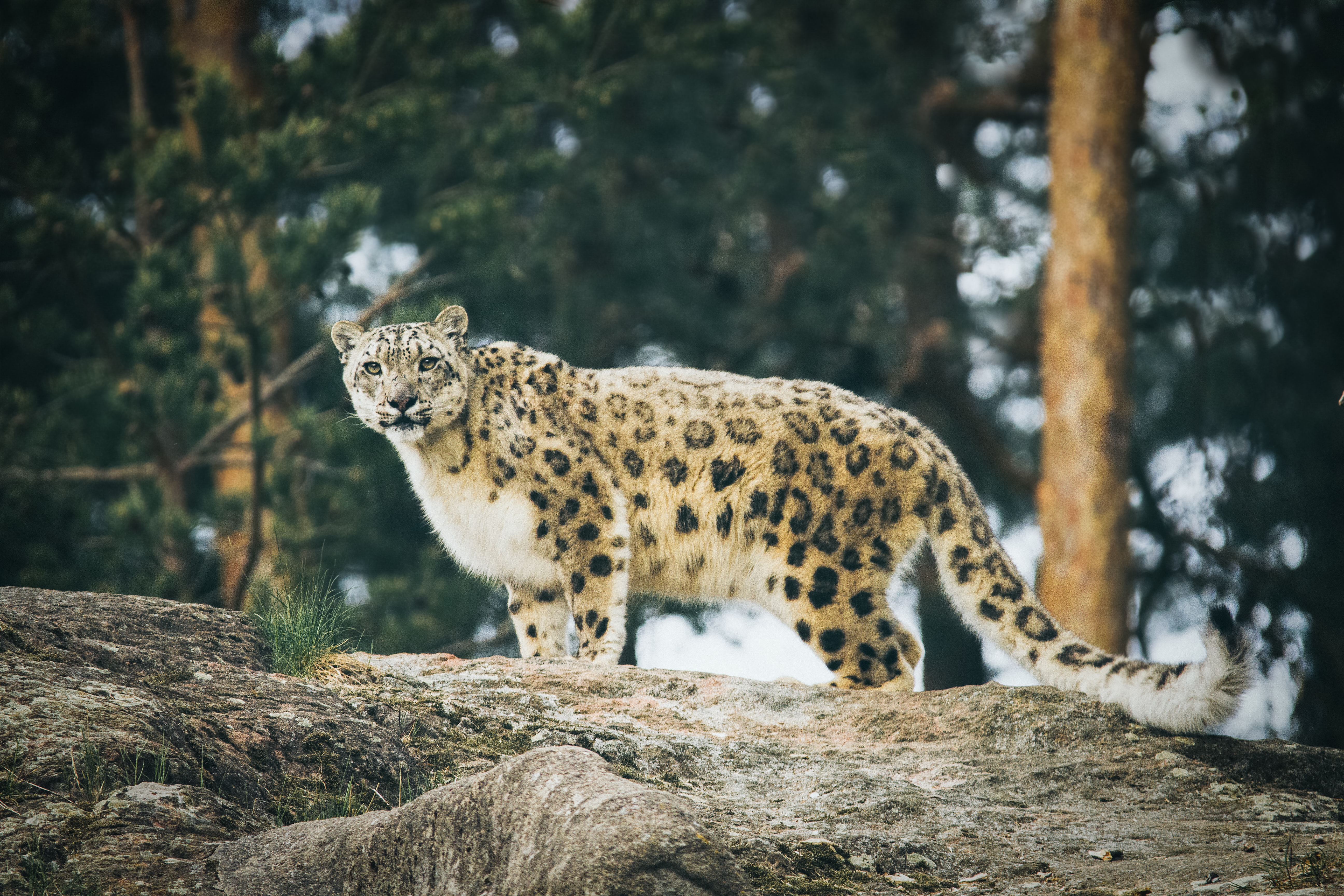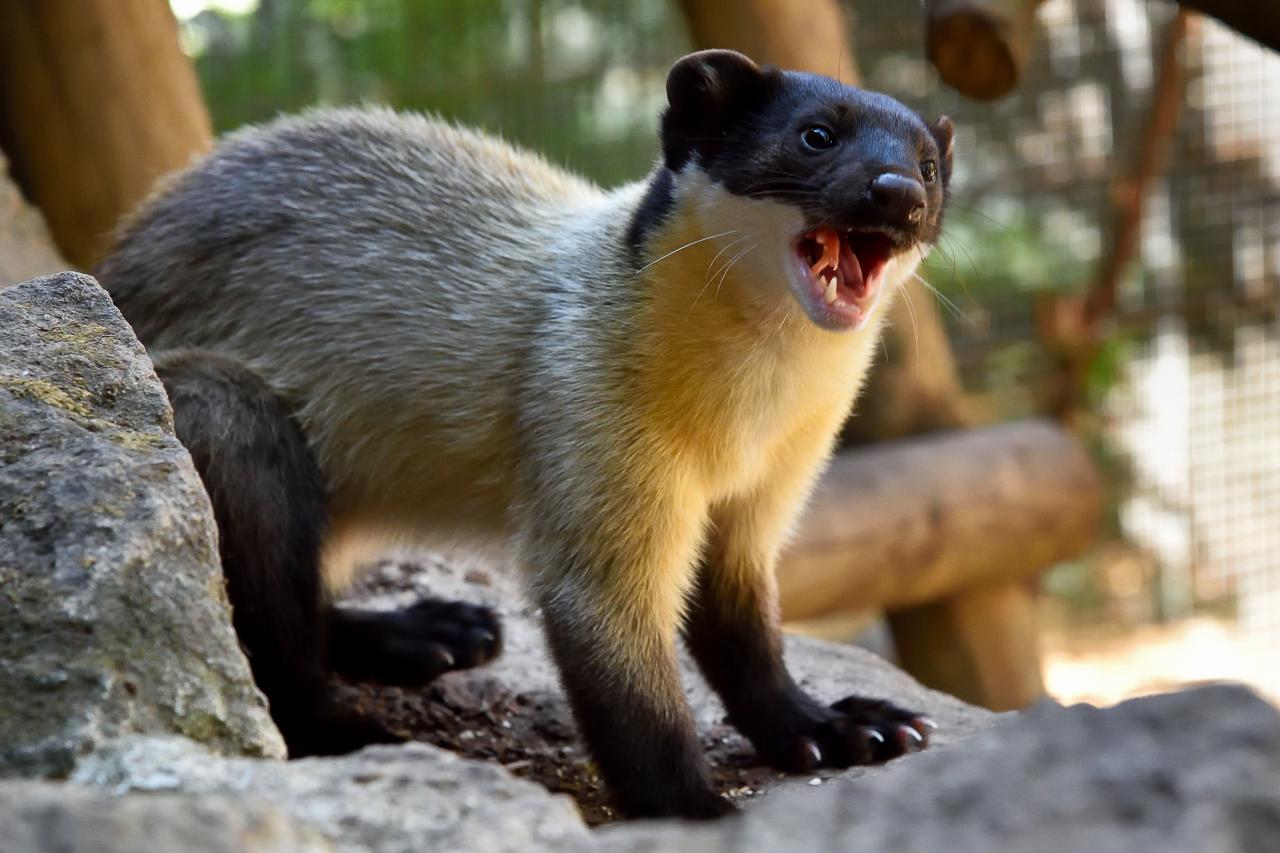The red panda is like many other animals a potential prey for those with whom it shares its habitat. It should be noted that predation is not a cause of extinction, but one of the rules that govern an ecosystem. Indeed, predators feed and populations that are prey are regulated!
Some of the natural predators of the red panda include:
Clouded leopard (Neofelis nebulosa)
IUCN Status: Vulnerable

Class: Mammals
Order: Carnivora
Family: Felidae
Size: 50 to 60 cm at withers
Length: up to 2 m depending on the adult individuals (80-90 cm for the tail)
Weight: between 18 and 23 kg at adult size
Particularity: This is the cat with the largest canines from a point of view proportional to its size.
Diet: rodents, monkeys, birds, pangolins, small deer.
Longevity: Estimated at 11 years in the wild (data not yet important enough for a reliable figure), between 13 and 15 years in captivity (record being 19 years!)
Geographic range: Continental South East Asia to Nepal and much of southern China.
Status: A species classified in Appendix 1 of CITES and therefore prohibited trade in animals or in parts. Less than 10,000 wild individuals, classified as vulnerable by IUCN
Threats: Habitat fragmentation due to deforestation, poaching of adult mothers to turn young into pets, and poaching for local cultures (owning a fur is a social status mark in some countries – especially in Taiwan where it has completely disappeared – the organs replace those of the tiger in traditional Chinese medicine where they are openly sold)
Captivity: Since 1973, the species benefits from a worldwide breeding plan managed by the World Association of Zoos and Aquaria (WAZA). The aim was to develop a growing captive population so that wild individuals would no longer be harvested. Unfortunately it is a very difficult species to reproduce in zoological parks, and most of the captive individuals were in the United States. It was therefore necessary in 2011, faced with an aging population, to bring captive individuals from Asia to restore a reproductive boom to the species and develop the program towards Europe. Since then, some pairs are prolific, which gives a hope of conservation for the species, for possible reintroductions in areas where it has disappeared, if the environment is secure and stable for the future of the individuals.
There is a very strong partnership between the zoological parks around the world that host this species, which led to the creation of the CLOUDED LEOPARD PROJECT. Thus, each of them must have crucial objectives: to promote the maximum welfare of the animals, to offer a food respecting the diet of the species, to continue scientific studies because still too rare among wild populations, and above all to encourage reproduction in order to sustain the future of the species in the long term (forecasts over a minimum of 100 years) thanks to breeding programs.
The Indian leopard (Panthera pardus fusca)
IUCN Status: : Vulnerable

Class: Mammals
Order: Carnivora
Family: Felidae
Size: Varies between 45 and 78 cm at withers
Length: up to 1.60 m (tail length 55-90 cm)
Weight: 58 kg for the male, 37 kg for the female (even up to 80 kg for individuals living in areas where there are no tigers, because the prey is more abundant!)
Diet: small animals, deer, monkeys. In urban areas, pets and livestock account for 25% of its food, and sometimes even dogs and children unattended.
Longevity: 12 to 15 years in the wild, up to 23 years in captivity (with a record of 26 years!)
Geographic range India, Nepal, Bangladesh
Status: Classified as Vulnerable by IUCN since 2016, population of approximately 15,000 wild individuals but increasing. CITES Appendix 1.
Threats: Poaching for fur and traditional Asian medicine, conflicts with breeders, scarcity of prey.
Captivity: Since the beginning of the era of the menageries, the panthers were not studied at all and many crosses between subspecies were carried out. Fortunately, thanks to scientific research and the involvement of zoological parks in this field since the early 1960s – 1970, 9 subspecies are now identified, while others have unfortunately disappeared since, described by explorers or scientists of the time.
Each is divided into natural areas between Africa and Asia, and since the creation of breeding programs for the most threatened among them (such as the Amur leopard or the Java leopard) no hybridization is tolerated in order to keep genetically reliable populations in captivity.
The only reintroduction program currently underway for one of these subspecies is the Amur Leopard in Eastern Siberia, as it is classified as a critically endangered species (only 50 individuals listed in 2016). Orchestrated by the AMUR LEOPARD CONSERVATION TRUST, the TIGRIS program and the NGO WILDCATS CONSERVATION ALLIANCE, and evidently supported by numerous institutions, some captive individuals born in zoological parks of the United States, Canada, Russia, and even a male born in France, will discover day-life on the spot so that their descendants are reintroduced into nature.
Many zoological parks support associations and NGOs of field for the protection of other subspecies of panthers that do not yet benefit from reintroduction programs, the Human/Animal conflict being still too important in their environments of life.
Snow leopard (panthera uncia)
IUCN Status: Vulnerable

Class: Mammals
Order: Carnivora
Family: Felidae
Size : 60 cm at withers
Length : up to 2.30 m depending on the adult individuals (0.90 cm to 1.10 m for the tail)
Weight : between 40 and 55 kg
Diet : Especially high mountain herbivores, including goats (bharals, takins, mouflons, markhors, etc.), occasionally small mammals and birds, many plants such as herbs and twigs (proportionally to other felines).
It is only an occasional predator of the red panda, because it lives in very steep and rugged terrain of high mountains (up to 6000 m of altitude), favoring open areas for a better visibility for predation purposes, so almost no big tree.
Longevity : About 15 years in the wild, about 20 years in captivity.
Geographic range : Much of Central Asia, from Russia to Nepal and Bhutan, from Pakistan to China.
Status : Species classified in Appendix 1 of the CITES, therefore trade prohibited animals or parts.
Estimated populations between 4500 and 9000 wild individuals, species classified as vulnerable by IUCN since 2017 (previously endangered)
Threats : The extension of livestock grazing areas limits the range of its prey, which also makes them rarer. The snow leopard thus willingly attacks cattle, so the breeders hunt it in retaliation. Moreover, marmots and other rodents that it feeds on are often poisoned because they are considered pest. It is also poached for its fur and for traditional Chinese medicine.
Captivity : The first individuals to be observed in captivity date back to the late 1800s. The earliest births occurred around 1910. As the species reproduces quite well, the first breeding programmes began around 1970, which greatly increased the populations, so genetically speaking that the Russian zoological parks, Japanese, Australian and Indian programs began in the late 1980s. As a result, no wild individuals would be taken from the wild.
At the moment, there have been so many births that some breeding programs recommend not to reproduce certain couples, because they are too genetically represented! A simple contraceptive implant is necessary to not sterilize individuals in case of potential reintroduction.
In order to rapidly advance the possibilities of reintroduction, almost all the zoological parks hosting the species financially support the SNOW LEOPARD TRUST, which studies and develops conservation programs with wild snow leopards. One of the priority actions carried out: The association finances secure enclosures for livestock, if the breeders commit to no more killing leopards, and not poisoning the local wildlife considered pest.
Yellow-throated marten(martes flavigula))
IUCN Status: Least concern
Class: Mammals
Order: Carnivora
Family : Mustelidae
Size / Weight : can be more than one metre long (head to tail), and weigh up to 3.5 kg
Longevity : 10 to 15 years
Diet : This little-known animal is rather omnivorous. Marten eat small animals as well as nuts or fruits. However, it can also hunt larger animals such as young cervids in groups. The red panda is not a usual prey but the marten is opportunistic. It can hunt young red pandas if the opportunity arises.
It is found in a wide variety of habitats, from the Himalayan zone in southern Indonesia to the northern Korean peninsula. It mainly inhabits the forests.

